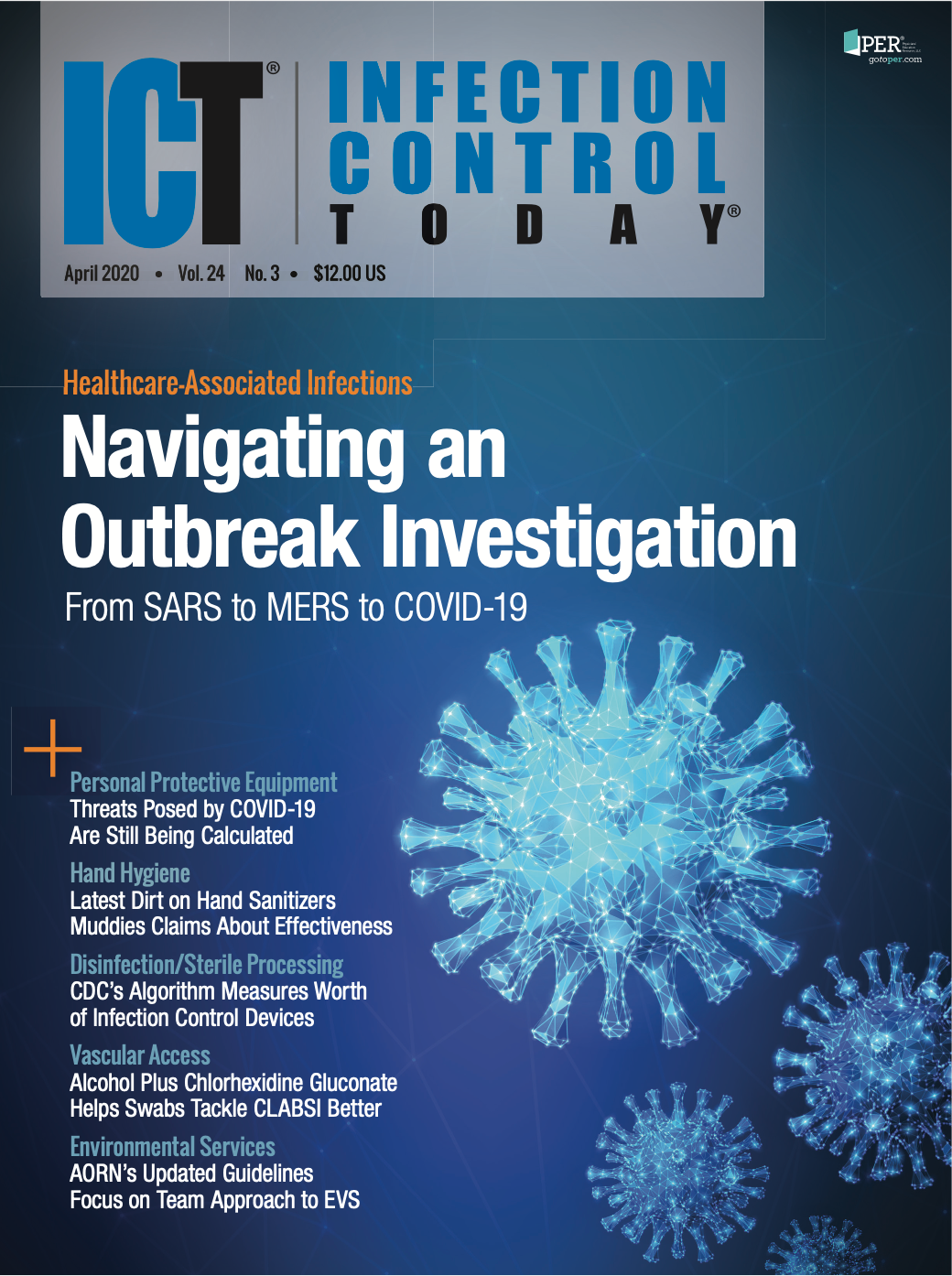CDC Devises Method for Reviewing Onslaught of New Infection Control Devices
The tool uses nodes, lettered A to O, that assess products in a way that spans labeling, marketing, and regulatory data, says the CDC. It provides a rigorous standardized method for review.

Think of it, says Vineet Chopra MD, MSc, as being a sort of Good Housekeeping Seal of Approval for infection prevention products. Chopra is chief of the division of hospital medicine at VA Ann Arbor Health System. He’s also the corresponding author of an article that lays out a new system that infection preventionists (IPs), hospital administrators, and others on the frontlines of infection control can use to evaluate infection control devices.
“That’s precisely what we were thinking about when we were creating the tool,” Chopra tells Infection Control Today® of the Good Housekeeping analogy. “If you’re a busy IP in a hospital and are thinking about investing in new technology, how could you tell if it was worth it? This approach also focuses on what data sources/evidence matters when you need to make the choice and sends a signal to industry as to what sources of truth we will be considering when reviewing products.”
Chopra and co-investigators published the article outlining how the tool-a 1-page framework form-works last November in the Annals of Internal Medicine. Healthcare officials can access the framework in the article or on the US Centers for Disease Control and Prevention’s (CDC) website. The tool was created by the Products and Practices Workgroup of the CDC’s Healthcare Infection Control Practices Advisory Committee (HICPAC).
HICPAC was charged with developing a process that would educate healthcare officials at the CDC, hospitals, and other settings about product choices. That covers a lot of ground, from ultraviolet light cleaning enhancers used by the environmental services (EVS) staff to the silver alginate dressings for the prevention of central line-associated bloodstream infections (CLABSIs) that Chopra’s article uses as one of its examples.
“It was purposefully defined to be as broad as possible,” Chopra says. “So, our definition includes the gamut of devices from dressings, coatings, disinfectant devices, et cetera.”
The tool involves use of what the article calls nodes, lettered A to O. The Products and Practices Workgroup, which met quarterly from July 2017 to November 2018, included representatives of the US Food and Drug Administration (FDA), the CDC, and members of medical professional societies.
The workgroup wanted product assessments to “span labeling, marketing, and regulatory data; evidence supporting use of a product; a summary of benefits and harms; consideration of effectiveness and generalizability; and resource implications,” the article states. “The workflow provides, for the first time, a rigorous, standardized method for reviewing products for infection prevention. It also broadens the type of information guideline writers will be able to review when considering products within infection prevention recommendations.”
Chopra says that, “Our initial indicators are that it has many page views. As to whether it will catch on? Time will tell.”
Linda Spaulding RN, CIC, BC, CHEC, CHOP, an infection prevention consultant and a member of ICT®'s Editorial Advisory Board, thinks that the tool will provide hospital administrators and IPs with some direction. “There have been so many products coming on the market that it is more important than ever for hospitals and IPs to do complete evaluations,” says Spaulding, who served as a liaison member of the HICPAC working group.
Connie Steed, MSN, RN, CIC, FAPIC, the president of the Association for Professionals in Infection Control and Epidemiology (APIC), says that the tool was designed for HICPAC and CDC and won’t necessarily affect the day-to-day for IPs or hospital administrators; they may use it way down the line, though.
“I think it’s a very comprehensive tool,” says Steed. “There’s so much innovation going on that when they’re reviewing guidelines, they need to look at what’s out there.”
She adds that the framework’s rigorousness makes it time-consuming. “It was not intended for infection preventionists to use but I could see where it would be helpful to infection preventionists,” says Steed, adding that it’s not really ready for hospitals to use either-yet.
“In the future, you may see this used by a healthcare organization,” says Steed.
On the other hand, manufacturers of infection control devices might find the tool very useful. “It gives you really a roadmap to what HICPAC and CDC is looking at in a product that they would recommend and a guideline for you to reduce infection risk. It’s very detailed. I’ve learned a lot by looking at the tool and understanding things that we need to be looking for as we assess products.”
Chopra said Steed is correct in saying that the tool right now is designed to determine how HICPAC will make product recommendations. He adds, however, that Steed is also correct that hospital administrators and IPs will hopefully find the tool useful someday.
“We didn’t design this to be a research tool,” Chopra says. “Rather, it was designed to be a pragmatic approach to looking at the evidence and data. One that we hope will diffuse beyond CDC and HICPAC.”
As the article states, the manufacture and sale of such devices represents a $27 billion industry, with an annual growth rate of 4.9%. In the beginning and throughout most of its history, the CDC focused on healthcare delivery practices in infection prevention and not so much on the products used in that effort, confining its focus in that arena to “general categories,” as the article puts it.
Chopra tells ICT® that “manufacturers and industry often will focus on specific outcomes. Evidence and peer-review may or may not focus on these. And FDA labels may or may not support the use of a product for that specific indication. This tool bridges the gap.”
HICPAC found instances where an FDA-approved device was used for something other than what it was meant for “when we did our review of the silver alginate and mupirocin products, for example,” Chopra says. “This may not all be negative-but the gaps are important to know.”
HICPAC did 3 test runs on products that might be used on neonatal intensive care units (NICUs). They included, as mentioned, silver alginate dressings for the prevention of CLABSIs.
“The tool was extremely useful when assessing the closed medication delivery system for the NICU CLABSI guideline because it led to the discovery that the product was not FDA-approved but rather a homemade, institution-specific device,” the article states. “The algorithm did identify clinically relevant human outcomes and the possibility of increased workload for nurses using the equipment. Evidence on generalizability, effect, and superiority of this product was not available, and the quality of the evidence in the guideline-review process was low. Therefore, the balance of benefits and harms assessed was unclear, and data summated from the tool did not support a recommendation that the product be used in neonates to reduce CLABSI.”
Chopra tells ICT®that he can see several ways in which the tool can be used. “First, when choosing product A vs. product B for a specific need, this tool can help examine the data for both in a systematic way,” he says. “Second, the tool can be a great way for IPs to look for evidence for existing products to determine whether or not there is support for continued use. Third, the ability to think about resource implications to maintain a product is a new and important dimension that IPs and clinicians can use when looking at products and making decisions.”
The tool may also help avoid situations of false advertising with infection prevention products such as hand sanitizers. For instance, in January the FDA fired off a warning letter to GOJO Industries, the makers of Purell hand sanitizer products, saying that some of the claims made about those products on social media platforms were misleading. Specifically, the agency took umbrage with Purell’s claims that its products can reduce or prevent infection from Ebola, methicillin-resistant Staphylococcus aureus(MRSA), vancomycin-resistant Enterococcus (VRE), norovirus, influenza, and Candida auris.
“Failure to promptly correct these violations may result in legal action without further notice, including, without limitation, seizure and injunction,” the letter stated.
Samantha Williams, GOJO’s senior director of corporate communications, told ICT®in Februarythat the company took “immediate action” upon receiving the FDA letter, adding that “it is our responsibility to ensure that we comply with all requirements of FDA regulations and federal law, and we take that responsibility very seriously.”
She also said that the letter was not related to the safety or quality of Purell products, or of the company’s manufacturing processes.
When asked how the HICPAC algorithm might have helped to prevent this situation, Chopra said “hindsight is 20/20.”
“The first few nodes of our algorithm that examine what the listed FDA indications for the product are would have caught this issue as it is currently written,” he told ICT®. “Of course, this all assumes that the nodes are followed and the directions are acted on by those using the tool.”
Spaulding points to what Chopra describes as the “high degree of variation in the process through which hospitals make decisions about devices and products. Our hope is that this will streamline that approach-provide guidance where none truly exists.”

The Sterile Processing Conference Survival Guide: How to Make the Most of Your Next Event
March 25th 2025From expert speakers to cutting-edge tools, sterile processing conferences, like the 2025 HSPA Annual Conference and the SoCal SPA's Spring Conference, offer unmatched opportunities to grow your skills, expand your network, and strengthen your department's infection prevention game.
Redefining Material Compatibility in Sterilization: Insights From AAMI TIR17:2024
March 24th 2025AAMI TIR17:2024 provides updated, evidence-based guidance on material compatibility with sterilization modalities. It offers essential insights for medical device design and ensures safety without compromising functionality.